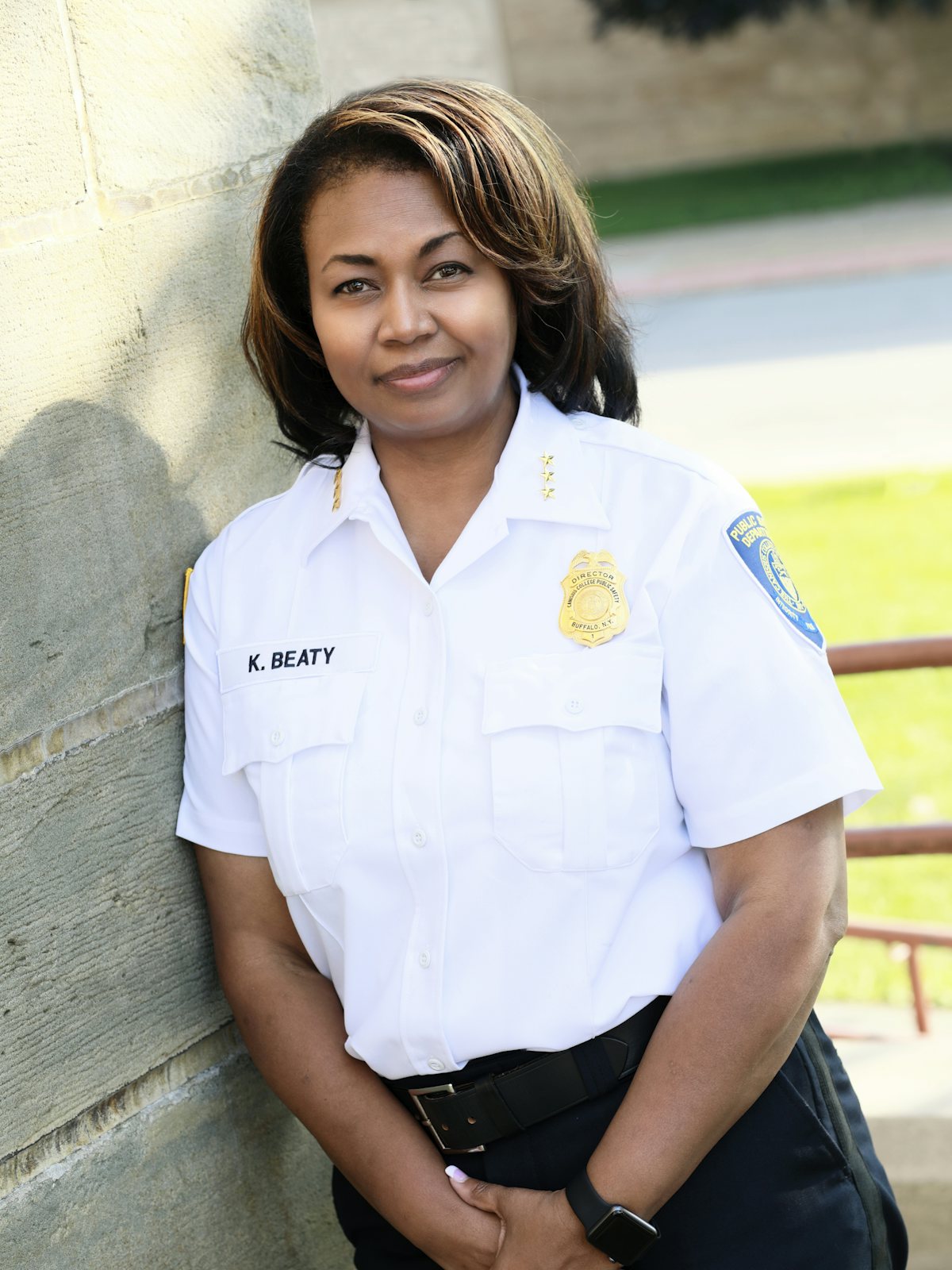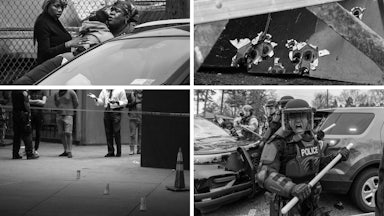Erie County Sheriff and Trump superfan Timothy B. Howard should be as notorious as Joe Arpaio, the famously racist Republican sheriff of Maricopa County, Arizona, whom Howard sees as a kindred spirit. Yet few outside of Western New York have ever heard of Howard. That’s not for want of headline fodder: Thirty-one people have died in Erie County jails since his appointment, most as a result of suicide or medical neglect. Many more have attempted suicide.
Howard was first appointed and then elected sheriff in 2005, and reelected in 2009, 2013, and 2017. Yet despite his well-documented and appalling record, the protests of conditions in his jails that local groups and organizers have held on a weekly basis since 2009, the dozens of people and organizations who have signed letters to elected officials demanding he be removed from office, he is finally leaving the sheriff’s office on his own terms. Instead of seeking reelection this year, he intends to run for town supervisor of the 3,000-person town of Wales, New York. Erie County residents finally have a chance to clean house.
It’s uncertain if they will. Although Democrats vastly outnumber Republicans in Erie County, voters haven’t elected a Democrat to the sheriff’s office since 1993. But change is afoot: In the heavily Democratic county seat of Buffalo, Democratic nominee India Walton’s presence has enlivened the mayor’s race; she could become the city’s first woman mayor and the first socialist mayor of a sizable U.S. city since 1960. High turnout is expected.
Howard’s preferred successor is John Garcia, who won the Republican primary. Democratic nominee Kim Beaty and independent candidate Ted DiNoto are also vying to replace Howard. DiNoto’s presence in the race could help Beaty by fracturing the non-Democratic vote. Karen Healy-Case, who was running on the Conservative Party line, shocked many by announcing on October 12 that she was suspending her campaign and backing Beaty. She’ll still appear on the line but is no longer actively campaigning.
Beaty would be Erie County’s first Black and first woman sheriff. Given the failure of nearly every effort to reform the sheriff’s office to date—not to mention outspoken Howard critic Myles Carter’s loss in the Democratic primary and failure to qualify for the general—a Beaty victory may also be the last, best hope of ensuring better treatment for those who wind up in county jails.
Carter’s platform was by far the boldest of the original field; he vowed to end solitary confinement, employ fewer deputies, hire people trained in mental health and drug abuse counseling, and hold deputies liable for failure to report misconduct. But Beaty, who is running on a platform of transparency, accountability, better health care for detainees, ending solitary confinement, and restoring trust in the office, won nearly five times as many votes as Carter in the primary. Of the remaining candidates, she is the only one who is explicitly putting Howard’s brutal legacy on the ballot. She is also a test case for whether similar reformers might succeed elsewhere.
In recent years, voters in big cities like Austin, Chicago, Philadelphia, Los Angeles, and San Francisco have elected district attorneys who ran on strong progressive platforms. Alvin Bragg, who vowed during his campaign to decline all charges stemming from consensual sex work, rarely seek cash bail, and make clear that in his office “alternatives to incarceration should be the norm, not the exception,” won a crowded primary in June and is expected to be elected Manhattan’s first Black district attorney in November.
Similar efforts to elect progressive sheriffs have not yet fared as well. In 2016, a not particularly progressive Democrat named Paul Penzone finally unseated Arpaio. Three years later, Republican Mike Chapman defeated progressive Democrat Justin Hannah in the Loudoun County, Virginia, sheriff’s race, and Republican Sheriff Glen Hill narrowly beat progressive challenger Josh King in Prince William County, Virginia. That same year in East Baton Rouge, Louisiana, Republican Sheriff Sid Gautreaux III fended off challenges from Democrats Charles “Carlos” Jean Jr. and Mark Milligan, both of whom campaigned on promises to withdraw from the 287(g) program, which deputizes local law enforcement officers to work with federal immigration enforcement; and to incarcerate fewer people, end the use of solitary confinement, and stop jail deaths.
Erin Heaney, national director of Showing Up for Racial Justice, or SURJ, a group that organizes in majority-white communities to bring more white people into anti-racist movements and has endorsed both Walton and Beaty, said SURJ is supporting Beaty for a number of reasons.
“We see the sheriff’s office as really critically important in advancing a whole bunch of reforms and changes in the criminal legal system in the region,” she said. Noting the progressive focus on district attorney’s races, she added that sheriff’s races have been overlooked throughout the country, even though sheriffs “control so much that has to do with mass incarceration.” SURJ believes Beaty will hold violent officers accountable and work with the state to implement reforms that the state Department of Corrections has said are needed.
“We don’t think that one candidate alone is
going to save us,” Heaney said, “but we do think that we have a shot at
advancing a much more progressive agenda on a number of issues when Kim’s in
office.… We want Kim to be the one who’s driving the decision-making because we
think she’s much more likely than John Garcia to listen to the needs of people
who are more directly impacted.”
Many factors matter in county sheriff’s races, including incumbency, name recognition, and community support. But race and gender also make the list. According to a 2020 report by the Reflective Democracy Campaign, white men comprise 30 percent of the U.S. population and 90 percent of elected sheriffs. Fewer than 3 percent of U.S. sheriffs are women, and fewer than 1 percent are women of color. In April, Beaty told The Buffalo News that Jeremy Zellner, the chair of the county’s Democratic Committee, had discouraged her from running, saying, “You’re not what a sheriff looks like, and what people are used to.” (Zellner, a white man, denied that he said that and rallied behind Beaty after she won the primary.)
Zellner’s preferred
candidate in the primary
was Assistant Police Chief Brian
Gould, a white moderate from the predominantly white town of Cheektowaga, New
York. And although Beaty ultimately won the primary, Gould
won
24 of the county’s 28 cities and towns and
beat her by 858 votes in Cheektowaga, 682 votes in Hamburg, and at least 290
votes in Evans, West Seneca, and Lancaster, the predominantly white town where Beaty lives. The bulk of her support came from Buffalo voters. Republican
Garcia won
every city and town in the county in the
GOP primary. A general election has different dynamics, but the primary results
suggest that suburban and rural voters may in fact be likelier to support a
candidate who “looks like” most sheriffs. (Garcia, who was born in Spain and identifies as a
first-generation Hispanic American, looks
like a white man and speaks with a Buffalo accent.)
That she is not what the sheriff has looked like
in living memory could be a problem for Beaty, though not an insurmountable
one, particularly now that local Democratic leadership is behind her. But other
obstacles remain. One is her relationship with Walton, the Democratic mayoral candidate.
If elected, Beaty and Walton would each be the first woman and the first Black woman
to hold their respective offices. Both challenged their party’s preferred candidates
in primaries and won. (Zellner, who now supports Walton, similarly discouraged her from running.) Joining forces could generate news coverage,
drive enthusiasm, and boost turnout.
But while Beaty needs Buffalo Democrats to win, she is reluctant to associate with Walton, whom she perceives as potentially alienating to other crucial voters, or even to encourage supporters to vote on the Democratic line, which is tantamount to advising they vote for Walton. In a recent interview on a local politics podcast, Beaty answered a question about whether she was coordinating with Walton like so: “I’m a resident of Lancaster … and I’m a candidate for a countywide race.… I have to generate support from everyone throughout the county, and I’m going to work hard for whoever the voters in the city of Buffalo elect as their mayor.… I’m eager to get started on the real work of reforming a broken system and restoring trust, and that includes the residents of the city of Buffalo, and I do want them to come out for me and support the Erie County sheriff’s race.… I can’t tell you enough, I live in Lancaster.”
Beaty’s caution may be well advised. But Heaney says that she and her fellow Beaty supporters have received encouraging responses in predominantly white suburbs. Given Howard’s narrow margin of victory in 2017, SURJ is targeting Democrats who didn’t vote in that race. “We are talking to people about the deaths in the Holding Center … people are disgusted by it,” she said, adding that some had been in county jails themselves or had loved ones detained there. “For any woman of color, overcoming systemic racism is an obstacle,” Erin Riker, treasurer of the Cheektowaga Democratic Town Committee, said, but once suburban Democrats hear about “Kim’s policies and background, once they know what she’s about and learn about her qualifications and what she stands for,” she’s confident they’ll support her.
Former Erie County legislator Betty Jean Grant, who spearheaded an effort to get Beaty back in the race after she briefly withdrew earlier this year, dismissed concerns about her countywide appeal and electability as a “pretext” to discourage her from running. “Since the election of Barack Obama, I think color has less to do with how people choose their candidate,” she said. “To say that a Black person could only win in Buffalo is painting people as racist and narrow-minded, and in this day and age, I see that less and less.”
Policing remains a hot topic in the Buffalo mayor’s race. Incumbent Byron Brown—who is running a write-in campaign after losing the Democratic primary and being denied an independent ballot line—is a law-and-order Democrat who famously refused to say that the police officers who attacked a 75-year-old protester last summer, sending him to the hospital with a brain injury and a fractured skull, should have been fired. Garcia backs Brown for mayor. Walton is a democratic socialist who has called for cutting the police budget and removing violent officers from the force.
The
sheriff’s race, while arguably more important, has attracted far less press, in
part because the contrasts among the candidates aren’t as vivid or clear. All
of the candidates are current or retired police officers. Beaty was deputy
commissioner of the Buffalo Police Department. Garcia is a retired homicide
detective. DiNoto is a detective lieutenant with the Amherst Police Department.
Healy-Case is a retired Buffalo police lieutenant.
Healy-Case, who withdrew from the race and now supports Beaty, initially took the most reactionary stance, railing against “the radical left” and the “defund the police mob” and saying that “keeping this office in Republican hands is the only way we can end the chaos and keep Erie County citizens safe.” How she got from that to supporting the Democratic nominee is anybody’s guess. Conservative and GOP leaders likely wanted her to drop out after Garcia buried her in the GOP primary, but they certainly didn’t want her to back Beaty. Healy-Case told The Buffalo News that Beaty is “intelligent” and has the right experience for the job.
While the three remaining viable candidates represent different parties and constituencies, they speak similarly in public. All but Healy-Case have at least obliquely criticized the way the sheriff’s office has been run. At a recent forum Garcia admitted, “Obviously there’s a lot of issues in the sheriff’s office” and vowed to professionalize it. Asked what he thought of Howard’s legacy, DiNoto told me that while the office has had “issues,” he wasn’t going to “lay blame on anyone” because “hammering Tim Howard really doesn’t do me any good.… I’m not firing Tim Howard, he’s leaving on his own.”
Beaty alone has gone after Howard by name. “I don’t know of a single Democrat who wants to let Tim Howard’s hand-picked successor continue his unprofessional and downright dangerous legacy,” she said on a podcast, referring to Garcia.
Illustrating both the power and the limits of the movement for criminal justice reform, all three have claimed to embrace concepts and language favored by that movement, whether or not they have embraced the movement itself. Even Garcia has abandoned Howard’s Dirty Harry pose, pivoting from messianic Howardian flourishes (the sheriff once likened support for body cameras to the audacity of those who doubted the resurrection of Jesus) to vague commitments to help inmates experiencing mental health crises, build empathy, and ensure public trust. Garcia and DiNoto say they favor both body cameras and restorative justice programming. In marked contrast to Howard, Garcia said he favored “any way to make the office transparent, modern, and professional,” and enthused that restorative justice programming was “across the board a great idea.”
Yet
crucial differences remain. Garcia is backed by Howard, the police union, and a
number of unions representing other law enforcement officers. He has said he was
“outraged by things like bail reform,” which eliminated
cash bail for most misdemeanors and nonviolent felonies and drastically reduced
the number of people in Erie County jails. Garcia has never
objected to the fact that a sheriff’s deputy convicted of beating
a young man served
no jail time at all. “They
mention people getting killed or beat up at a Bills game,” he said at a forum,
referring to critics of the sheriff’s office, “but they don’t see the brave men
and women who go to work every day and do a lot of good.”
DiNoto, a registered Republican who initially tried to secure the support of the local GOP, is positioning himself as an apolitical moderate, but he’s not as apolitical as he imagines himself to be. When I pointed out that voters who supported Howard will likely vote for Garcia and asked why anyone interested in reform should support him over Beaty, DiNoto replied, “To me it looks like she’s aligned herself on that new democratic socialist way of running, and I think people are afraid of that.”
His response to a question about how last summer’s anti–police brutality protests had affected the race also revealed a less than apolitical perspective. “They definitely raised an issue,” he said. “I’m not looking at things politically … the majority of them were riots, not protests, and I will say it. I’m a law enforcement officer, and if you protest, you have every right to protest peacefully … but the second you start criminal behavior, we’re going to step in.” Suddenly remembering his message of nonpartisanship, he concluded, “So, you know, I’m keeping the politics out of it,” before adding, “What I saw were riots, not protests.”
While Beaty, who is not running as a democratic socialist, is notably fearful of forging an alliance with Walton, who is, she’s less shy about criticizing Howard and promising reforms. “Incarcerated people are still people, and entitled to be treated with human dignity and respect,” reads a section of her website. “Over the last 16 years over 30 people have lost their lives and dozens more have reported incidents of abuse or neglect—it’s unacceptable.”
Garcia has nearly $191,000 in his campaign account, $200 of which came from a dentist whose 36-year-old son was charged with ripping the badge off a police officer and stealing his radio during the Capitol riot. Garcia has spent over 2.3 times as much as his Democratic rival. Lawn signs bearing his name can be seen throughout Erie County suburbs and in some Buffalo neighborhoods. Beaty has just $50,540, comparable to DiNoto’s $50,400. Even in politics, money isn’t everything. But it is an indicator that Garcia is dominating the race. And with just a few weeks to go before the election, it’s unclear how many county residents—particularly in Buffalo, where the mayor’s race has dominated local political coverage—even know there’s an active sheriff’s race, let alone an opportunity to replace one of the worst sheriffs in the country.
Most people in Erie County jails have never been
convicted of a crime and are merely awaiting trial. As a Legal Aid Bureau of
Buffalo attorney told me in 2019, people are often detained for offenses as minor
as driving with a suspended license or “mouthing off” to a police officer, which
is not a crime.
In 2014, a sheriff’s deputy pulled Julie Marinaro over for a minor traffic infraction. When Marinaro said, “Just give us the ticket,” the deputy detained her, her nanny, and three of her children in her car for 42 minutes. Marinaro told me that when she attempted to use a nearby restroom, he ordered her to stay in the car, saying that he didn’t care if she urinated on herself. After she refused to get back into the car, he handcuffed and arrested her in front of her children, at which point Marinaro lost control of her bladder. The deputy then charged her with obstructing governmental administration and detained her in the county holding center. Years later, in a separate incident, that deputy was convicted of reckless assault, official misconduct, and falsifying business records. Howard refused to fire him.
Far worse are the stories of those effectively sentenced to death for minor crimes and/or mental health crises. In July 2019, 44-year-old Connell Burrell collapsed at the Erie County Holding Center in downtown Buffalo. A slightly built man with type 2 diabetes and chronic obstructive pulmonary disease, he had served just 12 hours of a 15-day sentence on a disorderly conduct charge. After a seizure brought on by suspected medical neglect, he was transported to a local hospital and died two days later. One of his sisters, Monica Lynch, told me her brother was “a nice, considerate person, willing to do anything for anyone,” who served as “more of a father figure than an uncle” to another sister’s children. His own son was just 16 when Burrell died.
Three years earlier, India Cummings died at age 27 after spending just over two weeks in the same jail, where, according to a report by the state commission of correction, she received care “so grossly incompetent and inadequate as to shock the conscience.” Her mother, Tawana Wyatt, told me she had suffered many losses, but the loss of her daughter was “by far the worst.”
People with families and children have suffered and died in county jails throughout the United States—thousands without getting their day in court. Erie County jails are some of the worst in New York State, but people have also died in Pennsylvania’s Montgomery County Correctional Facility and St. Francois County jail in Missouri and Collin County jail in Texas. We don’t know how many people have died in Louisiana’s prisons, jails, and detention centers because the state keeps no official public tally. And while detainees are disproportionately Black and/or Latino—only 14 percent of Erie County residents are Black, yet Black people accounted for 61 percent of those in county jails as of June 2020—because there are more white people in the U.S. overall, most of those who die in U.S. jails are white.
Years of organizing by Black Lives Matter and other groups have raised awareness and increased public scrutiny of these deaths. But voters still have outsize respect for law enforcement officers and regard inmates as subhuman whether or not they have committed a crime. “There’s a reason they ended up in jail” is a common refrain. American jails are largely invisible to those who do not live, visit, or work in them. They’re hard to gain access to and often inconveniently located in remote areas. Officials are not transparent about or actively conceal what goes on inside them. It’s difficult to make people care about places they’ve never seen and can’t imagine they or a loved one ever will.
Electing Beaty sheriff and pressuring her to fulfill her campaign commitments is currently the best chance of ensuring that the people in Erie County jails are treated as if their lives are as valuable as those of their jailers. Voters may usher in a new future in November, if they reckon with the horrors of the present and past. How they decide—and what Beaty does in office if elected—could inspire people throughout the country to choose humanity over death and despair.










